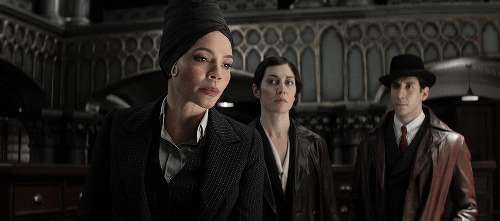Fantastic Feminism and Where to Find It
Fantastic Beasts and Where to Find Them is finally here! Not only is the movie storming up the box office rankings, but it is bursting with feminism too! From Hermione Granger and Minerva McGonagall to Bellatrix Lestrange, J.K. Rowling is well known for her strong, passionate, empowered female characters in the Harry Potter series, both good and evil, and Fantastic Beasts and Where to Find Them makes no exceptions to that. So grab a Time-Turner and take a look at four feminist moments we noticed in 1920s wizarding New York.
- Tina’s trousers
Aside from one scene in the Blind Pig, Tina Goldstein is always wearing trousers. Having formerly been on MACUSA’s investigative team, Tina made the choice to wear trousers, which makes sense given practicality and all the running around that comes with being an Auror. But trousers also hail to the position of feminism in 1926. Feminism was gradually growing in popularity at the time following the 19th Amendment granting women the vote in 1920, and fashion was changing too. Skirts were getting shorter, and while trousers were uncommon, they were becoming more popular. Trousers only became widely acceptable women’s wear in the mid-20th century, though. Does this suggest that Tina is ahead of her time?
- Seraphina Picquery
Picquery is introduced to us early on in the movie as President of MACUSA. She is well respected and highly regarded, as noticed in how she holds an emergency congress for wizarding world leaders, and is commonly referred to as “Madam.” While not always the most likable of leaders and despite the mistakes that she makes, the significance of her being a woman in an extremely high position is inspirational, especially when, to this day, no woman in the No-Maj-world has become President of the United States. However, Seraphina isn’t the first to do this. If we turn the Time-Turner back a little further, Emily Rappaport, the creator of Rappaport’s Law, was also President of MACUSA back in the 18th century.
- Queenie Goldstein
Embellished in pink flowing dresses and tightly curled blonde hair, Queenie’s appearance conforms to ideals of stereotypical femininity for the time. She’s mostly cited for her beauty, but that doesn’t mean that she isn’t a highly skilled witch and powerful Legilimens. Over the course of the movie, Queenie proves herself to be free-spirited, rebellious, and at times cunningly manipulative in order to help save the day. It’s nice to have a feminist figure who, while trying to rescue wizarding New York, is also very feminine.
- Aurors
Aurors, like in the later Harry Potter movies, have a huge role to play in Fantastic Beasts and Where to Find Them. Something I spotted in my second viewing of the movie was how there is an equal distribution of male and female Aurors visible in every scene that features their work. Want proof? Just take a look at any of the trailers released and see if you can spot the long-haired, makeup-faced Aurors standing alongside Seraphina Picquery and Percival Graves. There’s even an entire shot dedicated to showing us the high-heeled feet of a female Auror heading out to protect the city.
It’s wonderful to have a movie portraying feminism in so many different ways and lights, particularly given how the 1920s were a time when feminism and gender equality were becoming a little more commonplace in society. If you haven’t seen the movie, then keep an eye out for these when you get to your first screening. Already seen it? Well then, you’ll just have to go see Fantastic Beasts and Where to Find Them again and immerse yourself once more in J.K. Rowling’s wizarding world!





